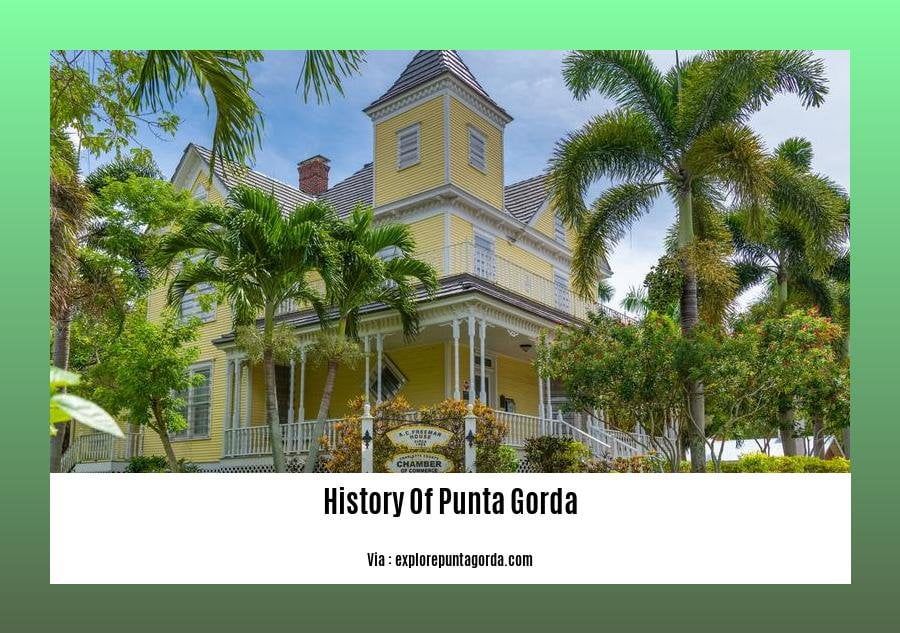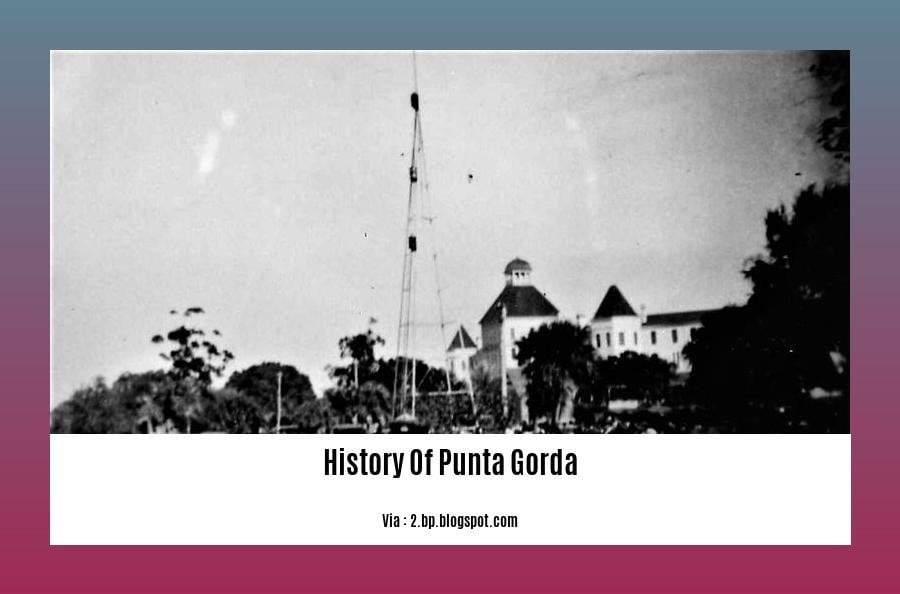Embark on a captivating journey through time as we delve into the rich history of Punta Gorda, a city steeped in heritage and captivating tales. From its humble beginnings as a fishing village to its transformation into a thriving cultural hub, Punta Gorda’s past is a tapestry woven with fascinating stories and remarkable characters. [A Journey Through Time: Exploring the Rich History of Punta Gorda] will take you on an extraordinary voyage, unveiling the hidden gems and forgotten treasures that make this city truly unique.
Key Takeaways:
Punta Gorda’s history began in 1797 when Garifuna deportees from San Vicente were stranded in Roatan.
The settlement was founded in 1884 by surveyor Kelly Harvey working on a subdivision of Trabue.
Punta Gorda was incorporated on December 7, 1887, after the railroad’s arrival.
Prior to its incorporation, Punta Gorda was a small fishing village settled by Garifuna emigrants from Honduras.
The Hotel Punta Gorda’s construction played a significant role in the city’s development.
History of Punta Gorda

Punta Gorda, a charming city steeped in a rich tapestry of history, invites you on a captivating journey through time. Let’s delve into the annals of this remarkable place, uncovering the stories that have shaped its identity.
Humble Beginnings
The Garifuna people, resilient descendants of African and Indigenous Caribbean heritage, first settled in Punta Gorda in 1823, drawn by its idyllic shores and abundant fishing grounds. These resourceful settlers established a small fishing village, laying the foundation for the vibrant community that would emerge.
The Arrival of the Railroad
In 1884, surveyor Kelly Harvey embarked on a transformative endeavor, subdividing the land of Trabue, at the behest of entrepreneur Isaac Trabue. This pivotal moment marked the official founding of Punta Gorda, heralding a new era of growth and prosperity.
The arrival of the railroad in 1887 proved to be a catalyst for Punta Gorda’s rapid expansion. The construction of the iconic Hotel Punta Gorda further solidified the city’s status as a thriving destination, attracting visitors from afar who sought respite and adventure amidst its enchanting landscapes.
Incorporation and Beyond
On December 7, 1887, Punta Gorda took a significant step forward, incorporating as a city. This milestone marked the beginning of a new chapter in its history, as Punta Gorda embraced its role as a vibrant hub of commerce and culture.
Over the ensuing decades, Punta Gorda continued to flourish, its rich history intertwining with the stories of its people and the events that shaped their lives. The city weathered storms, both literal and metaphorical, emerging stronger each time.
Today, Punta Gorda stands as a testament to the enduring spirit of its people. Its streets and buildings whisper tales of a storied past, while its vibrant present reflects a deep appreciation for its heritage.
Discover the fascinating history of Puerto Princesa, a city with a rich cultural heritage, by clicking on history of Puerto Princesa. Similarly, explore the captivating past of Punta Gorda, Florida, a city with a unique blend of cultures, by clicking on history of Punta Gorda FL.
British Control and the Establishment of Fort Charlotte
During the 18th century, Britain held sway over vast tracts of land in North America, seeking to consolidate its dominance through military strongholds. In 1764, the British military set its sights on a strategic location in present-day Punta Gorda, Florida, known as Charlotte Harbor. This marked the genesis of Fort Charlotte, a crucial bastion designed to safeguard British interests in the region.
Fort Charlotte’s strategic significance stemmed from its position at the confluence of the Peace and Myakka Rivers, a vital waterway at the time. The fort served as a sentinel, guarding access to the interior and controlling trade routes with Native American tribes. The British recognized the harbor’s potential as a gateway to the Gulf of Mexico and a strategic point to monitor Spanish activities in Florida.
The construction of Fort Charlotte exemplified the British military’s engineering prowess. They erected a star-shaped fortress with earthen ramparts, capable of withstanding artillery fire. Inside the fort, barracks, storehouses, and other structures provided living and working spaces for the British garrison.
Despite its formidable defenses, Fort Charlotte faced challenges. It endured attacks from Native Americans and even a siege by Spanish forces in 1781. However, the fort’s strategic importance ensured its resilience. The British maintained control of Fort Charlotte until 1783, when the Treaty of Paris officially ended the American Revolutionary War and ceded Florida back to Spain.
Today, Fort Charlotte stands as a testament to the region’s rich history. Its ruins, located within the Charlotte Harbor Preserve State Park, offer visitors a glimpse into the pivotal role it played during British rule. The site invites exploration, allowing visitors to envision the fort’s former glory and the tumultuous events that unfolded within its walls.
Key Takeaways:
British Expansion: The establishment of Fort Charlotte exemplified Britain’s efforts to expand its control over North America during the 18th century.
Strategic Location: Situated at the confluence of the Peace and Myakka Rivers, Fort Charlotte held a strategic position for controlling trade routes and monitoring Spanish activities.
Fortified Stronghold: Constructed as a star-shaped fortress, Fort Charlotte showcased British military engineering expertise and provided a strong defense against attacks.
Native American Resistance: Despite its strength, Fort Charlotte faced challenges from Native American tribes who resisted British encroachment on their lands.
Spanish Siege: In 1781, Spanish forces laid siege to Fort Charlotte, highlighting the fort’s significance in the regional power struggles.
End of British Control: The Treaty of Paris in 1783 marked the end of British control over Fort Charlotte, with Florida reverting back to Spanish rule.
Historical Legacy: Fort Charlotte’s ruins, preserved within the Charlotte Harbor Preserve State Park, offer a glimpse into the region’s past and the pivotal role it played during British rule.
Sources:
The American Revolution and the Seminole Wars

The American Revolution and the Seminole Wars had a significant impact on the history of Florida and the development of the United States. During this tumultuous period, the Seminole people, who had long inhabited the lands that would become Florida, found themselves caught in the crossfire of imperial struggles and forced to fight for their survival and sovereignty.
The American Revolution brought significant changes to the political landscape of the region. In 1763, Britain ceded Florida to Spain as part of the Treaty of Paris that ended the French and Indian War. This transfer of power set the stage for a new era of conflict and upheaval in Florida.
During the American Revolution, the Spanish government in Florida supported the American colonists in their fight for independence from Britain. This support was motivated by a desire to weaken Britain’s hold on the continent and to expand Spanish influence in the region.
The Seminole people, who had a long history of conflict with the British, saw an opportunity to align themselves with the Americans in their fight against a common enemy. The Seminole provided valuable intelligence and support to the American forces, helping them to achieve several victories.
After the American Revolution, the Seminole people faced new challenges and threats. The United States, which had emerged as a new nation, was eager to expand its territory and to acquire Florida from Spain. The Seminole people, who had fought alongside the Americans during the Revolution, were now seen as obstacles to American expansion.
In 1819, the United States and Spain signed the Adams-Onís Treaty, which ceded Florida to the United States. This treaty marked the beginning of a new era of conflict between the United States and the Seminole people, who were determined to resist American encroachment on their lands.
The Seminole Wars, which spanned three decades from 1817 to 1858, were a brutal and bloody conflict that resulted in the forced removal of most of the Seminole people from Florida. The Seminole people fought valiantly against the United States Army, but they were ultimately defeated by the superior military power of the United States.
The Seminole Wars had a lasting impact on the history of Florida and the United States. The wars resulted in the opening up of Seminole lands for white exploitation and settlement, and the forced removal of the Seminole people from their ancestral homelands. The Seminole Wars also played a role in the development of American Indian policy, as the United States sought to establish a system of reservations and assimilation for Native Americans.
Key Takeaways:
- The American Revolution and the Seminole Wars had a significant impact on the history of Florida and the development of the United States.
- The Seminole people, who had long inhabited the lands that would become Florida, found themselves caught in the crossfire of imperial struggles and forced to fight for their survival and sovereignty.
- The Seminole people provided valuable intelligence and support to the American forces during the American Revolution, helping them to achieve several victories.
- After the American Revolution, the Seminole people faced new challenges and threats from the United States, which was eager to expand its territory and to acquire Florida from Spain.
- The Seminole Wars, which spanned three decades from 1817 to 1858, were a brutal and bloody conflict that resulted in the forced removal of most of the Seminole people from Florida.
- The Seminole Wars had a lasting impact on the history of Florida and the United States, resulting in the opening up of Seminole lands for white exploitation and settlement, and the forced removal of the Seminole people from their ancestral homelands.
Citations:
Development of Punta Gorda as a Fishing Village and the Arrival of Isaac Trabue
Imagine being Isaac Trabue, the visionary surveyor, and entrepreneur who first set foot on the shores of Punta Gorda in 1884. A land teeming with natural beauty and untapped potential, Trabue envisioned a thriving fishing village where people could cast their lines in the serene waters of Charlotte Harbor.
With a twinkle of ambition in his eye, Trabue laid out the town along the southern shores of the Peace River, strategically positioning it as a gateway to lucrative fishing grounds. His foresight proved impeccable as Punta Gorda rapidly blossomed into a bustling fishing hub, attracting anglers from far and wide.
The arrival of the railroad in 1887 further fueled Punta Gorda’s growth. It opened a direct route for tourists and fishermen seeking a taste of the city’s renowned fishing spots. The iconic Hotel Punta Gorda, a testament to the city’s burgeoning tourism, welcomed guests with its elegant charm and warm hospitality.
As word of Punta Gorda’s fishing prowess spread, so did its reputation as a winter destination. Seasonal visitors flocked to the city, eager to escape the harsh northern winters and immerse themselves in the tranquility of Punta Gorda’s sun-soaked shores.
The synergy between fishing and tourism breathed life into Punta Gorda’s economy. Fish markets lined the waterfront, bustling with activity as fishermen unloaded their daily catch. Restaurants served up delectable seafood dishes, tantalizing the taste buds of locals and tourists alike.
Over the years, Punta Gorda’s fishing industry evolved, adapting to the changing needs of the time. Commercial fishing remained a vital part of the city’s economic fabric, while recreational fishing soared in popularity. Anglers from across the country flocked to Punta Gorda, eager to test their skills against the harbor’s legendary fish populations.
Today, Punta Gorda stands as a testament to the vision of Isaac Trabue. Once a humble fishing village, it has transformed into a vibrant city that proudly embraces its rich fishing heritage. The legacy of Trabue lives on in the hearts of Punta Gorda’s residents, who continue to celebrate the city’s deep-rooted connection to the sea.
Isaac Trabue: A Visionary Pioneer
Isaac Trabue, the founder of Punta Gorda, played a pivotal role in shaping the city’s destiny. His vision, determination, and entrepreneurial spirit laid the foundation for Punta Gorda’s remarkable growth and prosperity.
Trabue’s legacy extends far beyond the city he founded. His pioneering spirit and unwavering belief in the potential of Punta Gorda continue to inspire generations of entrepreneurs and visionaries who are drawn to the city’s unique charm and boundless opportunities.
Key Takeaways:
- Isaac Trabue founded Punta Gorda in 1884, envisioning it as a thriving fishing village.
- The city’s strategic location on the shores of Charlotte Harbor and the Peace River made it an ideal destination for fishermen.
- The arrival of the railroad in 1887 fueled Punta Gorda’s growth, attracting tourists and anglers alike.
- Punta Gorda’s fishing industry flourished, becoming a vital part of the city’s economy.
- Today, Punta Gorda is a vibrant city that proudly celebrates its rich fishing heritage.
References:
- History of Punta Gorda | City of Punta Gorda, FL
- Punta Gorda History Center
FAQ
Q1: What was the original name of Punta Gorda?
A1: Prior to its incorporation, Punta Gorda was a small fishing village settled by Garifuna emigrants from Honduras in 1823. Some sources claim that Punta Gorda was founded shortly after April 12, 1797, when Garífuna deportees from San Vicente were stranded on Roatan by the British.
Q2: When was Punta Gorda founded?
A2: Punta Gorda was founded in 1884 by Isaac Trabue, a surveyor and entrepreneur. The city was officially incorporated on December 7, 1887, after the arrival of the railroad and the construction of the Hotel Punta Gorda.
Q3: What were the primary industries in Punta Gorda during the late 19th and early 20th centuries?
A3: During the late 19th and early 20th centuries, Punta Gorda’s primary industries were agricultural trade and fishing. The city was a popular destination for tourists and fishermen, and its economy thrived as a result.
Q4: How did Hurricane Charley impact Punta Gorda?
A4: Punta Gorda was devastated by Hurricane Charley in 2004. The hurricane caused widespread damage to the city, including the destruction of many historic buildings. However, the city has since been rebuilt and is now a thriving community.
Q5: What are some of the notable features of Punta Gorda today?
A5: Today, Punta Gorda is known for its beautiful waterfront parks, system of pathways for walking and bicycling, and a collection of independent shops & restaurants. The city is also home to the Punta Gorda History Center & Punta Gorda Historical Society, which is dedicated to preserving and promoting the city’s rich history.
















